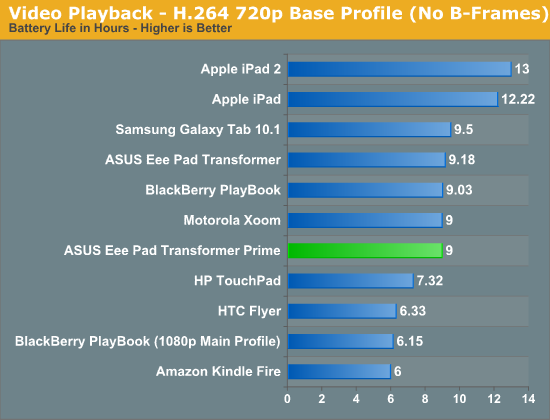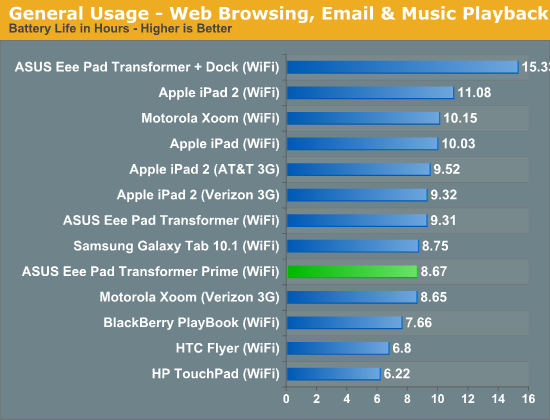ASUS Eee Pad Transformer Prime & NVIDIA Tegra 3 Review
by Anand Lal Shimpi on December 1, 2011 1:00 AM ESTBattery Life
With 39 hours to test I was pretty limited in what I could do when it came to battery life testing. I was able to run through two tests (one run a piece) and only in one configuration each. I wanted to see how Tegra 3 and the Prime fared in the worst case scenario so I picked the Normal power profile. Over the coming days I'll look at battery life in the other two profiles as well, not to mention run through more iterations of our test suite.
My bigger concern has to do with the malfunctioning WiFi in my review unit. For our video playback battery life test WiFi was on but not actively being used, those numbers should be ok. It's our general use test that loads web pages and downloads emails over WiFi and it's there that I believe things could've suffered a bit.
In both cases I saw around 9 hours of continuous battery life out of the Transformer Prime, without its dock. These numbers are a bit lower than the original Transformer but it's unclear to me how much of this is due to the additional cores/frequency or the misbehaving WiFi. The fact that we're within striking range of the original Transformer with the Prime running in Normal mode tells me that it's possible to actually exceed the Transformer's battery life with the Balanced or Power Saver profiles. That's very impressive for an SoC built on the same manufacturing process as its predecessor but with twice the CPU cores and a beefier GPU.


What I'm not seeing however is the impressive gains in battery life NVIDIA promised its companion core would deliver. I'm not saying that the companion core doesn't deliver a tangible improvement in battery life, I'm just saying that I need more time to know for sure.
That the Transformer Prime can deliver roughly the same battery life as its predecessor without any power profile tweaking may be good enough for many users. Both ASUS and NVIDIA shared their own numbers which peg the Prime's battery life in the 10 - 13 hour range. As I mentioned before, I'll have more data in the coming days.
Update - With a replacement Transformer Prime in house, battery life is looking a lot better already:

Update 2: Even more battery life results in our follow-up.










204 Comments
View All Comments
ATOmega - Tuesday, December 6, 2011 - link
Exactly my reasoning, and it's easy enough to see that the Transformer Prime boasts better features like GPS, camera and display.After having owned an iPad2, there must be a reason why I want this thing. And it's for all the things Apple decided to fleece me on so that they could jack up their margins.
I never liked Apple in the first place, but it's obvious they don't want to truly compete with the Android OS.
sigmatau - Thursday, December 1, 2011 - link
I was really hoping Nvidia would have something special with kal-el. This is pretty horrible when compared to hardware that has been available for about a year.It seems that the Nvidia-equiped tablets should be targeted at a much lower price point. They definetly should not be in the top tier tablets. I can see them selling at $300 or less.
UpSpin - Thursday, December 1, 2011 - link
Don't forget the display brightness. I don't think that the processor makes such a huge difference in power consumption, but the display on the Prime is much much brighter than the display of the iPad, and this will consume a huge amount of power. It's also brighter than the display of the first gen transformer, and the prime has a quad core and it gets the same or higher battery life than the first gen, I think that's really a big improvement.And if you want to use a tablet on the go, outside the house, you really need the brightest display possible. And as you can see in the picture, the difference between the sunlight visibility of the iPad and Prime is like day and night. Therefore I at least, sacrifice the 3 hours less battery life.
name99 - Thursday, December 1, 2011 - link
The display surely only uses more power if you drive it at a brighter level?And a well-designed tablet should have a light sensor, and should do a good job of auto-calibrating the brightness to the environment, so that most of the time it is NOT running the screen in bright mode. After all, that's what we expect regarding the core --- we throttle CPU when it's not needed. So, sorry, I don't think this is an acceptable answer.
I continue to state my original thesis --- I suspect that DRAM power is substantially more important than most people believe, and that one of Apple's advantages is that they ship iOS devices with minimal DRAM. This is obviously a hassle for developers, and even for some power users, but that's the tradeoff one has to make.
(Also what's the story with Android and VM? iOS does NOT do any "write" swapping --- code is paged in, but data is not paged out, and I expect that this is a power issue, nothing else --- Apple doesn't want the power hit of swapping.
I thought Android was like this --- did not write pages --- but I have read stuff recently that said no, it is now using standard desktop type VM, which is likely also a power sink.)
metafor - Thursday, December 1, 2011 - link
nVidia's solution is actually much more sophisticated than that. It's similar to a method Intel started using a ways back for laptops.It's not just auto-dimming the entire screen; it's auto-dimming every pixel individually. There is fine-grain control over the LED backlight of the display. Areas in each frame that contains black will now not only have the LCD crystal for that pixel in a "block" mode, but it will also have the backlight for that specific pixel dim.
This actually produces benefits other than just battery life; one of the biggest problems with LCD's is that blacks aren't really black because the crystal isn't able to block 100% of the backlight.
By dimming the backlight, the parts of an image that is supposed to be black will be closer to true black. This improves contrast and provides for more accurate pictures.
UpSpin - Friday, December 2, 2011 - link
how shall this work if the backlight is created by an LED array at the edge, which almost all smaller (<20") displays are. So with an edge lit backlight you can't reduce the LED brightness block wise.This is different if the used panel has a full array of LEDs, which is expensive, more power consuming and thicker, so a no go on a mobile device that thin. And neither Intel nor Nvidia have impact on this, because this requires a different panel.
TechAnandUser - Friday, December 2, 2011 - link
BenchMarking App's are not yet optimized. So please wait !!fteoath64 - Friday, December 2, 2011 - link
Why would you want a Win8 tablet ?. Its slow, heavy, short battery-life and probably cost 50% more!.You are better off with a mid-range slim laptop which you probably have. So unless you grab one of these or already have an ipad, you have no idea what a tablet can do for you.eddman - Friday, December 2, 2011 - link
You might have a time machine then, cause right now there are no win 8 tablets, let alone ARM based ones.tipoo - Thursday, December 15, 2011 - link
"Its slow, heavy, short battery-life and probably cost 50% more"Citation needed, citation needed, citation needed, and citation needed respectively. None of us have tested finalized W8 table hardware yet, unless you are from the future.